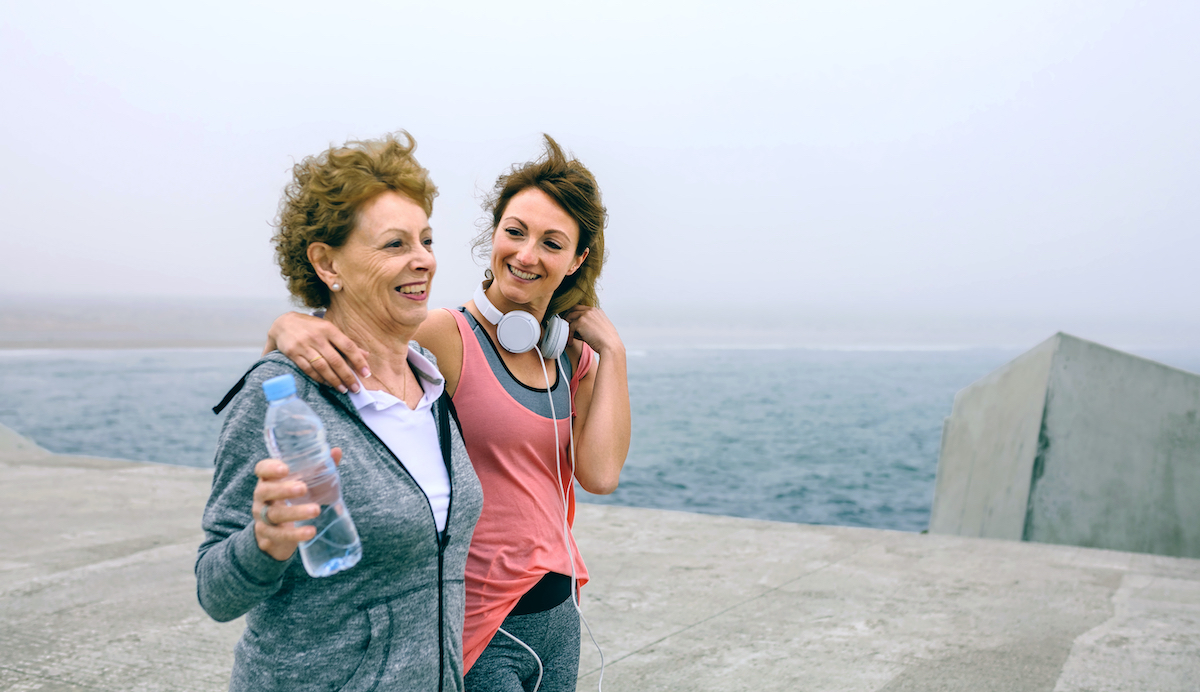Secrets for Walking Your Way to a Lean Body After 50

The body slows down naturally with age, and while you may have been able to lift really heavy weights, take regular HIIT classes, or run ten miles in the A.M. religiously in your 20s and 30s, it'll be harder to maintain those hardcore habits up when you're 50 and beyond. "As you age, your body experiences compositional changes like a decrease in muscles mass," says Steve Stonehouse, NASM, CPT, USATF Certified Run Coach and Director of Education for STRIDE. As the amount of muscle mass—as well as your strength and definition—continues to decline with age, your metabolism progressively slows down, too. "A slower metabolism leads to less energy in the day," he says.
This is why walking more as you age is more important than ever. "Physical activity is not only key to maintaining a lean body but also maintaining and improving mobility," he says.
What's more, walking is the ultimate do-anywhere activity that people in their 50s and over can do regularly without worrying much about excess pressure on the muscles and joints or increased risk of injury, fractures or falls. And, believe it or not, it's also a great way to burn fat, lose weight, and get lean.
"Walking is one of the most underrated exercises for weight loss," trainer and health coach Ryan Hodgson recently explained to Express. "Too often in the mainstream media we are seeing overweight people being pushed toward HIIT (high intensity interval training) workouts, circuits, couch to 5k and much more…. Many of these forms of exercise are much more likely to promote injury. If we could do more to promote walking for weight loss, it would be a huge step in the right direction."
If you're interesting in walking your way to a leaner body as you age, the key is to make your walks more challenging by adding in certain elements that will increase calorie burn and help build muscle mass. What that in mind, here are some great walking tips Stonehouse recommends for those aged 50 and over. All of these suggestions will increase heart rate to maximize those fitness gains and help you lean out. So read on—and if walking is your thing, don't miss The Secret Cult Walking Shoe That Walkers Everywhere Are Obsessed With.
Add in Weights

Osteoporosis, when your bones weaken, is a common issue in individuals 50 and up. Adding some progressive weight bearing to your walks will lower your risk of osteoporosis and help build bone density, which starts to decrease, as you get older. "Even just a few extra pounds on a walk can help improve your bone density while improving your overall health from the exercise," he says.
Bump up the intensity with one or two hand weights (lightweight sets are fine) or wear a weighted vest, backpack, belt or ankle weights—whatever feels most comfortable for you.
Add in a Jog or Run Throughout

If running isn't your thing, or you can't due to injury or other health conditions like joint stiffness, try a jog. Or even if jogging the entire distance seems too daunting, start off small and incorporate a few seconds of a jog at a time for a few intervals throughout your walk. Or try a run or sprint boost—if you're comfortable with the output and physically capable, then go for it!
Try adding in 10-30 seconds of jogging into your waking routine, with repetition for a few times throughout your whole walking workout. "The running will help improve bone density from the pressure you had while running but walking will allow you to maintain some level of low intensity exercise and protect your joints," he says.
Try these two examples that he suggests: 20 minutes of work (run 2 mins/walk 3 mins) for four sets or 30 minutes of work (run 4 mins/walk 2 mins) for five sets. And if walking is your thing, don't miss The Secret Cult Walking Shoe That Walkers Everywhere Are Obsessed With.
Do Interval Walking

If running or jogging is too much still, try speed walking in place of the running. "The goal is to spike your heart rate, which will improve your cardiovascular endurance and make you fitter," he says. "You can use the above exercise for walk/run and simply choose to speed walk instead," he says.
In general, these walking exercises will improve your muscle strength and coordination, as you also build up core strength and keep those pounds off. For more on the benefits of adding difficulty to your walks, see Why This Amazing Walking Workout Is Going Viral.
Take Frequent Short Walks to Split it Up

If a lengthy walk or interval training session is not realistic for your body or your schedule, break it up into shorter walks dispersed throughout the day.
This is a great way to get in the whole walk but keep pressure off the body by not overwhelming it too heavy a task, and it also gives your body the chance to get your heart rate up and some steps in multiple times in the day, as opposed to just once during the single workout.
This means your metabolism may stay higher throughout the whole day than it would have if you just did one workout for the day, instead. "Try a morning walk for your dog, then you can spread out 10–15-minute walks every 3-4 hours," he says.
As you get more comfortable with being on your feet and more physically agile and strong you can incorporate more intense forms of walking, like the ones listed above. And for more great exercise advice, see here for The One Exercise That's Best for Beating Back Alzheimer's, Says Doctor.








